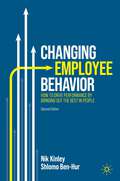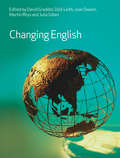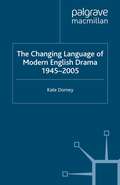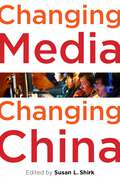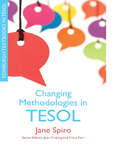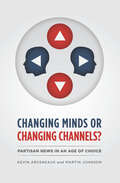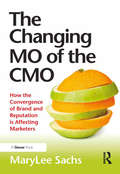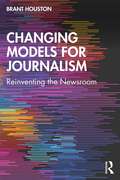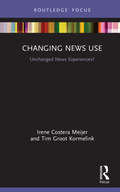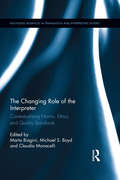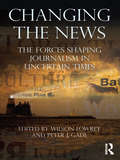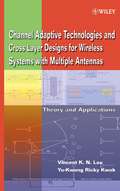- Table View
- List View
Changing Employee Behavior: How to Drive Performance by Bringing out the Best in People
by Nik Kinley Shlomo Ben-HurAn important part of every manager's job is changing people's behavior: improving someone’s performance, helping them better manage relationships with colleagues, or sometimes even stopping them doing something. Yet, despite the fact that changing people's behavior is such a fundamental skill for managers, there is little in the way of systematic support for them to go about it.This book changes that, revealing simple but powerful techniques for changing behavior that experts from a range of disciplines have been using for years. Drawing upon proven methods from psychology, psychotherapy, and behavioural economics, it presents a comprehensive toolkit that managers can use to improve the performance of staff and address some of the most common challenges they face. With a new foreword and three new chapters, this revised edition expands on the original by showing how organisations and leaders have used the techniques presented in it, how these methods have become even more relevant in the post-pandemic world, and how it has been applied the broader challenge of workplace culture change. Finally, supplementary videos add detail to this new content, with examples and explanations presented by the authors.Videos via app: download the SN More Media app for free, scan a link with play button and access videos directly on your smartphone or tablet.
Changing English: History, Diversity And Change
by David GraddolChanging English examines the history of English from its origins in the fifth century to the present day. It focuses on the radical changes that have taken place in the structure of English over a millennium and a half, detailing the influences of migration, colonialism and many other historical, social and cultural phenomena. Expert authors illustrate and analyze dialects, accents and the shifting styles of individual speakers as they respond to changing circumstances. The reader is introduced to many key debates relating to the English language, illustrated by specific examples of data in context.Including key material retained from the earlier bestselling book, English: History, Diversity and Change, this edition has been thoroughly reorganized and updated with entirely new material. Changing English:explains basic concepts, easily located through a comprehensive indexincludes contributions by experts in the field, such as David Crystal, David Graddol, Dick Leith, Lynda Mugglestone and Joan Swanncontains a range of source material and commissioned readings to supplement chapters.Changing English makes an essential contribution to the field of English language studies.
Changing English
by David Graddol Dick Leith Joan Swann Martin Rhys Julia GillenChanging English examines the history of English from its origins in the fifth century to the present day. It focuses on the radical changes that have taken place in the structure of English over a millennium and a half, detailing the influences of migration, colonialism and many other historical, social and cultural phenomena. Expert authors illustrate and analyze dialects, accents and the shifting styles of individual speakers as they respond to changing circumstances. The reader is introduced to many key debates relating to the English language, illustrated by specific examples of data in context.Including key material retained from the earlier bestselling book, English: History, Diversity and Change, this edition has been thoroughly reorganized and updated with entirely new material. Changing English:explains basic concepts, easily located through a comprehensive indexincludes contributions by experts in the field, such as David Crystal, David Graddol, Dick Leith, Lynda Mugglestone and Joan Swanncontains a range of source material and commissioned readings to supplement chapters.Changing English makes an essential contribution to the field of English language studies.
The Changing Language of Modern English Drama 1945–2005
by K. DorneyAn account of language and drama between 1945 and 2005, synthesizing linguistic and dramatic knowledge in order to illuminate the ways in which anxieties and attitudes toward language manifest themselves in discourses on and around English theatre of the time, and how these anxieties and attitudes reflect back through the theatre of this period.
Changing Media, Changing China
by Susan L. ShirkThirty years ago, the Chinese Communist Party (CCP) made a fateful decision: to allow newspapers, magazines, television, and radio stations to compete in the marketplace instead of being financed exclusively by the government. The political and social implications of that decision are still unfolding as the Chinese government, media, and public adapt to the new information environment. Edited by Susan Shirk, one of America's leading experts on contemporary China, this collection of essays brings together a who's who of experts--Chinese and American--writing about all aspects of the changing media landscape in China. In detailed case studies, the authors describe how the media is reshaping itself from a propaganda mouthpiece into an agent of watchdog journalism, how politicians are reacting to increased scrutiny from the media, and how television, newspapers, magazines, and Web-based news sites navigate the cross-currents between the open marketplace and the CCP censors. China has over 360 million Internet users, more than any other country, and an astounding 162 million bloggers. The growth of Internet access has dramatically increased the information available, the variety and timeliness of the news, and its national and international reach. But China is still far from having a free press. As of 2008, the international NGO Freedom House ranked China 181 worst out of 195 countries in terms of press restrictions, and Chinese journalists have been aptly described as "dancing in shackles." The recent controversy over China's censorship of Google highlights the CCP's deep ambivalence toward information freedom. Covering everything from the rise of business media and online public opinion polling to environmental journalism and the effect of media on foreign policy, Changing Media, Changing China reveals how the most populous nation on the planet is reacting to demands for real news.
Changing Media, Changing China
by Susan L. ShirkThirty years ago, the Chinese Communist Party (CCP) made a fateful decision: to allow newspapers, magazines, television, and radio stations to compete in the marketplace instead of being financed exclusively by the government. The political and social implications of that decision are still unfolding as the Chinese government, media, and public adapt to the new information environment. Edited by Susan Shirk, one of America's leading experts on contemporary China, this collection of essays brings together a who's who of experts--Chinese and American--writing about all aspects of the changing media landscape in China. In detailed case studies, the authors describe how the media is reshaping itself from a propaganda mouthpiece into an agent of watchdog journalism, how politicians are reacting to increased scrutiny from the media, and how television, newspapers, magazines, and Web-based news sites navigate the cross-currents between the open marketplace and the CCP censors. China has over 360 million Internet users, more than any other country, and an astounding 162 million bloggers. The growth of Internet access has dramatically increased the information available, the variety and timeliness of the news, and its national and international reach. But China is still far from having a free press. As of 2008, the international NGO Freedom House ranked China 181 worst out of 195 countries in terms of press restrictions, and Chinese journalists have been aptly described as "dancing in shackles." The recent controversy over China's censorship of Google highlights the CCP's deep ambivalence toward information freedom. Covering everything from the rise of business media and online public opinion polling to environmental journalism and the effect of media on foreign policy, Changing Media, Changing China reveals how the most populous nation on the planet is reacting to demands for real news.
Changing Methodologies in TESOL (Edinburgh Textbooks in TESOL)
by Jane SpiroCovering core topics from vocabulary and grammar to teaching, writing speaking and listening, this textbook shows you how to link research to practice in TESOL methodology. It emphasises how current understandings have impacted on the language classroom worldwide and investigates the meaning of 'methods' and 'methodology' and the importance of these for the teacher: as well as the underlying assumptions and beliefs teachers bring to bear in their practice. By introducing you to language teaching approaches, you will explore the way these are influenced by developments in our understanding of language, learning technologies, learners, and their socio-cultural world. Three main areas in TESOL methods are covered: the impact of learner needs, context and culture on language, learning and teaching approaches; knowledge of language and its impact on methods, from the word to whole texts; and multiple literacies and competences for the modern world, including academic literacy and web literacy, socio-cultural and intercultural competence. The impact on teacher choices and methods of World Englishes, approaches to grammar, and learner development is also discussed. Each chapter illustrates core principles in practice using case studies of English teaching worldwide. Guided tasks, including article critique, case study analysis, and small-scale classroom research, prepare you to engage critically with research literature and use this analysis to inform your own practice. Key features* Written specifically for those studying TESOL teaching* First book to teach methods and practice in a global context, including links to the latest developments in the field* Encourages students to adopt a reflective approach to their teaching* Concepts and research are presented in an accessible way, regardless of the student's level of teaching experience or linguistic study* Provides task-based activities.
Changing Methodologies in TESOL (Edinburgh Textbooks in TESOL)
by Jane SpiroCovering core topics from vocabulary and grammar to teaching, writing speaking and listening, this textbook shows you how to link research to practice in TESOL methodology. Guided tasks prepare you to engage critically with research literature and use this analysis to inform your own practice.
Changing Minds or Changing Channels?: Partisan News in an Age of Choice (Chicago Studies in American Politics)
by Kevin Arceneaux Martin JohnsonWe live in an age of media saturation, where with a few clicks of the remote—or mouse—we can tune in to programming where the facts fit our ideological predispositions. But what are the political consequences of this vast landscape of media choice? Partisan news has been roundly castigated for reinforcing prior beliefs and contributing to the highly polarized political environment we have today, but there is little evidence to support this claim, and much of what we know about the impact of news media come from studies that were conducted at a time when viewers chose from among six channels rather than scores. Through a series of innovative experiments, Kevin Arceneaux and Martin Johnson show that such criticism is unfounded. Americans who watch cable news are already polarized, and their exposure to partisan programming of their choice has little influence on their political positions. In fact, the opposite is true: viewers become more polarized when forced to watch programming that opposes their beliefs. A much more troubling consequence of the ever-expanding media environment, the authors show, is that it has allowed people to tune out the news: the four top-rated partisan news programs draw a mere three percent of the total number of people watching television. Overturning much of the conventional wisdom, Changing Minds or Changing Channels? demonstrate that the strong effects of media exposure found in past research are simply not applicable in today’s more saturated media landscape.
Changing Minds or Changing Channels?: Partisan News in an Age of Choice (Chicago Studies in American Politics)
by Kevin Arceneaux Martin JohnsonWe live in an age of media saturation, where with a few clicks of the remote—or mouse—we can tune in to programming where the facts fit our ideological predispositions. But what are the political consequences of this vast landscape of media choice? Partisan news has been roundly castigated for reinforcing prior beliefs and contributing to the highly polarized political environment we have today, but there is little evidence to support this claim, and much of what we know about the impact of news media come from studies that were conducted at a time when viewers chose from among six channels rather than scores. Through a series of innovative experiments, Kevin Arceneaux and Martin Johnson show that such criticism is unfounded. Americans who watch cable news are already polarized, and their exposure to partisan programming of their choice has little influence on their political positions. In fact, the opposite is true: viewers become more polarized when forced to watch programming that opposes their beliefs. A much more troubling consequence of the ever-expanding media environment, the authors show, is that it has allowed people to tune out the news: the four top-rated partisan news programs draw a mere three percent of the total number of people watching television. Overturning much of the conventional wisdom, Changing Minds or Changing Channels? demonstrate that the strong effects of media exposure found in past research are simply not applicable in today’s more saturated media landscape.
Changing Minds or Changing Channels?: Partisan News in an Age of Choice (Chicago Studies in American Politics)
by Kevin Arceneaux Martin JohnsonWe live in an age of media saturation, where with a few clicks of the remote—or mouse—we can tune in to programming where the facts fit our ideological predispositions. But what are the political consequences of this vast landscape of media choice? Partisan news has been roundly castigated for reinforcing prior beliefs and contributing to the highly polarized political environment we have today, but there is little evidence to support this claim, and much of what we know about the impact of news media come from studies that were conducted at a time when viewers chose from among six channels rather than scores. Through a series of innovative experiments, Kevin Arceneaux and Martin Johnson show that such criticism is unfounded. Americans who watch cable news are already polarized, and their exposure to partisan programming of their choice has little influence on their political positions. In fact, the opposite is true: viewers become more polarized when forced to watch programming that opposes their beliefs. A much more troubling consequence of the ever-expanding media environment, the authors show, is that it has allowed people to tune out the news: the four top-rated partisan news programs draw a mere three percent of the total number of people watching television. Overturning much of the conventional wisdom, Changing Minds or Changing Channels? demonstrate that the strong effects of media exposure found in past research are simply not applicable in today’s more saturated media landscape.
Changing Minds or Changing Channels?: Partisan News in an Age of Choice (Chicago Studies in American Politics)
by Kevin Arceneaux Martin JohnsonWe live in an age of media saturation, where with a few clicks of the remote—or mouse—we can tune in to programming where the facts fit our ideological predispositions. But what are the political consequences of this vast landscape of media choice? Partisan news has been roundly castigated for reinforcing prior beliefs and contributing to the highly polarized political environment we have today, but there is little evidence to support this claim, and much of what we know about the impact of news media come from studies that were conducted at a time when viewers chose from among six channels rather than scores. Through a series of innovative experiments, Kevin Arceneaux and Martin Johnson show that such criticism is unfounded. Americans who watch cable news are already polarized, and their exposure to partisan programming of their choice has little influence on their political positions. In fact, the opposite is true: viewers become more polarized when forced to watch programming that opposes their beliefs. A much more troubling consequence of the ever-expanding media environment, the authors show, is that it has allowed people to tune out the news: the four top-rated partisan news programs draw a mere three percent of the total number of people watching television. Overturning much of the conventional wisdom, Changing Minds or Changing Channels? demonstrate that the strong effects of media exposure found in past research are simply not applicable in today’s more saturated media landscape.
Changing Minds or Changing Channels?: Partisan News in an Age of Choice (Chicago Studies in American Politics)
by Kevin Arceneaux Martin JohnsonWe live in an age of media saturation, where with a few clicks of the remote—or mouse—we can tune in to programming where the facts fit our ideological predispositions. But what are the political consequences of this vast landscape of media choice? Partisan news has been roundly castigated for reinforcing prior beliefs and contributing to the highly polarized political environment we have today, but there is little evidence to support this claim, and much of what we know about the impact of news media come from studies that were conducted at a time when viewers chose from among six channels rather than scores. Through a series of innovative experiments, Kevin Arceneaux and Martin Johnson show that such criticism is unfounded. Americans who watch cable news are already polarized, and their exposure to partisan programming of their choice has little influence on their political positions. In fact, the opposite is true: viewers become more polarized when forced to watch programming that opposes their beliefs. A much more troubling consequence of the ever-expanding media environment, the authors show, is that it has allowed people to tune out the news: the four top-rated partisan news programs draw a mere three percent of the total number of people watching television. Overturning much of the conventional wisdom, Changing Minds or Changing Channels? demonstrate that the strong effects of media exposure found in past research are simply not applicable in today’s more saturated media landscape.
Changing Minds or Changing Channels?: Partisan News in an Age of Choice (Chicago Studies in American Politics)
by Kevin Arceneaux Martin JohnsonWe live in an age of media saturation, where with a few clicks of the remote—or mouse—we can tune in to programming where the facts fit our ideological predispositions. But what are the political consequences of this vast landscape of media choice? Partisan news has been roundly castigated for reinforcing prior beliefs and contributing to the highly polarized political environment we have today, but there is little evidence to support this claim, and much of what we know about the impact of news media come from studies that were conducted at a time when viewers chose from among six channels rather than scores. Through a series of innovative experiments, Kevin Arceneaux and Martin Johnson show that such criticism is unfounded. Americans who watch cable news are already polarized, and their exposure to partisan programming of their choice has little influence on their political positions. In fact, the opposite is true: viewers become more polarized when forced to watch programming that opposes their beliefs. A much more troubling consequence of the ever-expanding media environment, the authors show, is that it has allowed people to tune out the news: the four top-rated partisan news programs draw a mere three percent of the total number of people watching television. Overturning much of the conventional wisdom, Changing Minds or Changing Channels? demonstrate that the strong effects of media exposure found in past research are simply not applicable in today’s more saturated media landscape.
The Changing MO of the CMO: How the Convergence of Brand and Reputation is Affecting Marketers
by MaryLee SachsMaryLee Sachs explores the relationship and increasing blur between the marketing discipline and the public relations profession. How do the two mix? What is their role in a world where the growth of digital and social media has contributed to an increasing lack of control over how brands are perceived? Drawing on the experiences of Chief Marketing Officers (CMOs) from 10 iconic organizations with business and consumer brands across the globe, The Changing MO of the CMO explores how some organizations are making the most of a blended approach to communications and marketing and how CMOs can respond to and prepare for their new responsibilities. It illustrates how PR can provide: ¢ authenticity, relevance and advocacy to marketing; ¢ integration of an organization's approach to paid, owned and earned media channels; ¢ a strategic risk management tool for assuring reputation and managing crisis communication. Changing the traditional roles of marketing and communications may be an imperative for organizations. That doesn't make it easy. This readable and credible short guide provides a sense of the opportunities and obstacles involved and the vision required to change the culture of marketing and communications. The Changing MO of the CMO is an important book for developing a new model of marketing; it should be read by all CMOs charged with defining and implementing changes.
The Changing MO of the CMO: How the Convergence of Brand and Reputation is Affecting Marketers
by MaryLee SachsMaryLee Sachs explores the relationship and increasing blur between the marketing discipline and the public relations profession. How do the two mix? What is their role in a world where the growth of digital and social media has contributed to an increasing lack of control over how brands are perceived? Drawing on the experiences of Chief Marketing Officers (CMOs) from 10 iconic organizations with business and consumer brands across the globe, The Changing MO of the CMO explores how some organizations are making the most of a blended approach to communications and marketing and how CMOs can respond to and prepare for their new responsibilities. It illustrates how PR can provide: ¢ authenticity, relevance and advocacy to marketing; ¢ integration of an organization's approach to paid, owned and earned media channels; ¢ a strategic risk management tool for assuring reputation and managing crisis communication. Changing the traditional roles of marketing and communications may be an imperative for organizations. That doesn't make it easy. This readable and credible short guide provides a sense of the opportunities and obstacles involved and the vision required to change the culture of marketing and communications. The Changing MO of the CMO is an important book for developing a new model of marketing; it should be read by all CMOs charged with defining and implementing changes.
Changing Models for Journalism: Reinventing the Newsroom
by Brant HoustonExploring the deep transformation that journalism has undergone in the last decade, this book provides students, professors and working journalists with the background on the demise of traditional media in the U.S. and the changes happening in the digital newsrooms. Houston discusses today’s changes in journalism in the U.S., comparing and contrasting them with those around the world. Topics discussed include the decimation of the traditional newsrooms, contemporary corporate ownership and investors, the rise of bloggers and digital journalism, finding new audiences, the surge in nonprofit newsrooms and collaborations, investigative centers in the U.S. and globally, new model start-ups, and changing streams of revenue with the expansion of new technologies. The text also looks at the new relationship between journalism professionals and the academy, including the rise in content and stories supplied by university-based newsrooms. Houston, who has been on the frontline of these changes, also discusses the culture clashes and ethical dilemmas in cyber environments accompanied by new challenges to maintaining credibility and creating trust. To fully explore the rapid-fire changes in news media and online journalism in recent years, this book will be of interest to students of journalism and communications, working journalists, and professors helping prepare budding journalists for their future careers in journalism.
Changing Models for Journalism: Reinventing the Newsroom
by Brant HoustonExploring the deep transformation that journalism has undergone in the last decade, this book provides students, professors and working journalists with the background on the demise of traditional media in the U.S. and the changes happening in the digital newsrooms. Houston discusses today’s changes in journalism in the U.S., comparing and contrasting them with those around the world. Topics discussed include the decimation of the traditional newsrooms, contemporary corporate ownership and investors, the rise of bloggers and digital journalism, finding new audiences, the surge in nonprofit newsrooms and collaborations, investigative centers in the U.S. and globally, new model start-ups, and changing streams of revenue with the expansion of new technologies. The text also looks at the new relationship between journalism professionals and the academy, including the rise in content and stories supplied by university-based newsrooms. Houston, who has been on the frontline of these changes, also discusses the culture clashes and ethical dilemmas in cyber environments accompanied by new challenges to maintaining credibility and creating trust. To fully explore the rapid-fire changes in news media and online journalism in recent years, this book will be of interest to students of journalism and communications, working journalists, and professors helping prepare budding journalists for their future careers in journalism.
Changing News Use: Unchanged News Experiences? (Disruptions)
by Irene Costera Meijer Tim Groot KormelinkChanging News Use pulls from empirical research to introduce and describehow changing news user patterns and journalism practices have beenmutually disruptive, exploring what journalists and the news media canlearn from these changes. Based on 15 years of audience research, the authors provide an in-depthdescription of what people do with news and how this has diversifiedover time, from reading, watching, and listening to a broader spectrumof user practices including checking, scrolling, tagging, and avoiding.By emphasizing people’s own experience of journalism, this book alsoinvestigates what two prominent audience measurements – clicking andspending time – mean from a user perspective. The book outlines ways toovercome the dilemma of providing what people apparently want (attentiongrabbingnews features) and delivering what people apparently need (whatjournalists see as important information), suggesting alternative ways toinvestigate and become sensitive to the practices, preferences, and pleasuresof audiences and discussing what these research findings might mean foreveryday journalism practice. The book is a valuable and timely resource for academics and researchersinterested in the fields of journalism studies, sociology, digital media, andcommunication.
Changing News Use: Unchanged News Experiences? (Disruptions)
by Irene Costera Meijer Tim Groot KormelinkChanging News Use pulls from empirical research to introduce and describehow changing news user patterns and journalism practices have beenmutually disruptive, exploring what journalists and the news media canlearn from these changes. Based on 15 years of audience research, the authors provide an in-depthdescription of what people do with news and how this has diversifiedover time, from reading, watching, and listening to a broader spectrumof user practices including checking, scrolling, tagging, and avoiding.By emphasizing people’s own experience of journalism, this book alsoinvestigates what two prominent audience measurements – clicking andspending time – mean from a user perspective. The book outlines ways toovercome the dilemma of providing what people apparently want (attentiongrabbingnews features) and delivering what people apparently need (whatjournalists see as important information), suggesting alternative ways toinvestigate and become sensitive to the practices, preferences, and pleasuresof audiences and discussing what these research findings might mean foreveryday journalism practice. The book is a valuable and timely resource for academics and researchersinterested in the fields of journalism studies, sociology, digital media, andcommunication.
The Changing Role of the Interpreter: Contextualising Norms, Ethics and Quality Standards (Routledge Advances in Translation and Interpreting Studies)
by Marta Biagini Michael S. Boyd Claudia MonacelliThis volume provides a critical examination of quality in the interpreting profession by deconstructing the complex relationship between professional norms and ethical considerations in a variety of sociocultural contexts. Over the past two decades the profession has compelled scholars and practitioners to take into account numerous factors concerning the provision and fulfilment of interpreting. Building on ideas that began to take shape during an international conference on interpreter-mediated interactions, commemorating Miriam Shlesinger, held in Rome in 2013, the book explores some of these issues by looking at the notion of quality through interpreters’ self-awareness of norms at work across a variety of professional settings, contextualising norms and quality in relation to ethical behaviour in everyday practice. Contributions from top researchers in the field create a comprehensive picture of the dynamic role of the interpreter as it has evolved, with key topics revisited by the addition of new contributions from established scholars in the field, fostering discussion and further reflection on important issues in the field of interpreting. This volume will be key reading for scholars, researchers, and graduate students in interpreting and translation studies, pragmatics, discourse analysis, and multilingualism.
The Changing Role of the Interpreter: Contextualising Norms, Ethics and Quality Standards (Routledge Advances in Translation and Interpreting Studies)
by Marta Biagini Michael S. Boyd Claudia MonacelliThis volume provides a critical examination of quality in the interpreting profession by deconstructing the complex relationship between professional norms and ethical considerations in a variety of sociocultural contexts. Over the past two decades the profession has compelled scholars and practitioners to take into account numerous factors concerning the provision and fulfilment of interpreting. Building on ideas that began to take shape during an international conference on interpreter-mediated interactions, commemorating Miriam Shlesinger, held in Rome in 2013, the book explores some of these issues by looking at the notion of quality through interpreters’ self-awareness of norms at work across a variety of professional settings, contextualising norms and quality in relation to ethical behaviour in everyday practice. Contributions from top researchers in the field create a comprehensive picture of the dynamic role of the interpreter as it has evolved, with key topics revisited by the addition of new contributions from established scholars in the field, fostering discussion and further reflection on important issues in the field of interpreting. This volume will be key reading for scholars, researchers, and graduate students in interpreting and translation studies, pragmatics, discourse analysis, and multilingualism.
Changing the News: The Forces Shaping Journalism in Uncertain Times (Routledge Communication Series)
by Wilson Lowrey Peter J. GadeChanging the News examines the difficulties in changing news processes and practices in response to the evolving circumstances and struggles of the journalism industry. The editors have put together this volume to demonstrate why the prescriptions employed to salvage the journalism industry to date haven’t worked, and to explain how constraints and pressures have influenced the field’s responses to challenges in an uncertain, changing environment. If journalism is to adjust and thrive, the following questions need answers: Why do journalists and news organizations respond to uncertainties in the ways they do? What forces and structures constrain these responses? What social and cultural contexts should we take into account when we judge whether or not journalism successfully responds and adapts? The book tackles these questions from varying perspectives and levels of analysis, through chapters by scholars of news sociology and media management. Changing the News details the forces that shape and challenge journalism and journalistic culture, and explains why journalists and their organizations respond to troubles, challenges and uncertainties in the way they do.
Changing the News: The Forces Shaping Journalism in Uncertain Times (Routledge Communication Series)
by Wilson Lowrey Peter J. GadeChanging the News examines the difficulties in changing news processes and practices in response to the evolving circumstances and struggles of the journalism industry. The editors have put together this volume to demonstrate why the prescriptions employed to salvage the journalism industry to date haven’t worked, and to explain how constraints and pressures have influenced the field’s responses to challenges in an uncertain, changing environment. If journalism is to adjust and thrive, the following questions need answers: Why do journalists and news organizations respond to uncertainties in the ways they do? What forces and structures constrain these responses? What social and cultural contexts should we take into account when we judge whether or not journalism successfully responds and adapts? The book tackles these questions from varying perspectives and levels of analysis, through chapters by scholars of news sociology and media management. Changing the News details the forces that shape and challenge journalism and journalistic culture, and explains why journalists and their organizations respond to troubles, challenges and uncertainties in the way they do.
Channel-Adaptive Technologies and Cross-Layer Designs for Wireless Systems with Multiple Antennas: Theory and Applications (Wiley Series in Telecommunications and Signal Processing #85)
by Vincent K.N. Lau Yu-Kwong Ricky KwokThis innovative book sets forth two promising wireless approaches that support high-quality, high-speed data and multimedia service-multiple antenna technologies and cross layer transmitter adaptation designs-while highlighting the relationships and interactions between them. The latest advanced technologies of channel adaptation techniques for wireless communication systems with multiple antennas are thoroughly investigated. The book is divided into three parts, first giving readers a good foundation in underlying theory, then exploring applications as well as advanced topics: * Part 1 examines theoretical aspects of channel adaptation in wireless communications for point-to-point and multi-user systems with multiple antennas * Part 2 focuses on the applications of the channel-adaptive technologies in practical systems such as UMTS * Part 3 delves into topics such as multi-user scheduling for wideband systems, combined queuing theory and information theory, and ad hoc routing Using a hands-on, practical approach, Channel Adaptive Technologies and Cross Layer Designs for Wireless Systems with Multiple Antennas thoroughly covers detailed design considerations that help readers understand how to apply theory to real-world systems. Emphasis throughout the book is on joint optimization across different layers of a communications system based on an integrated approach. Examples of popular wireless systems, such as TDMA, wideband CDMA (UMTS), and HSDPA, are used throughout as practical illustrations. Each chapter ends with a summary that reviews key points and a set of problems that lets readers test their knowledge and continue to develop their skills as they progress to new topics. Figures and tables are also used extensively to help readers visualize complex theory and systems. Combining theory, design, and application into one integrated approach, this is a superior reference for advanced communications theory courses.
